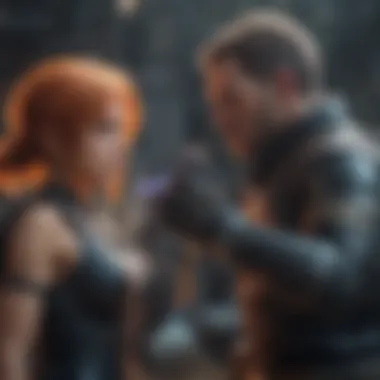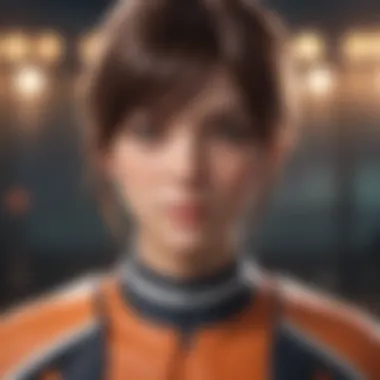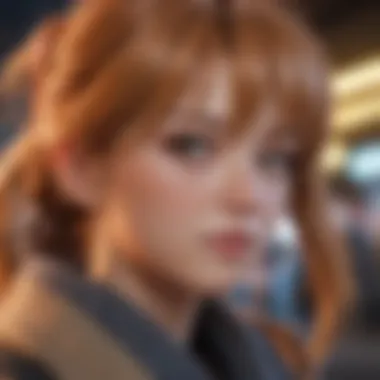Exploring the Dynamics of Anime Match Relationships


Intro
Anime matches stand out as some of the most captivating moments in this vibrant art form. They are not just about slam-bang action; they encapsulate deeper narratives and character arcs that resonate with audiences. To put it simply, anime matches often represent pivotal points in stories, reflecting the internal struggles and growth of characters. These whirlwind sequences meld together fast-paced animations, thematic depth, and cultural significance in a way that can evoke excitement and intense emotions.
In this exploration, we will dissect the dynamic layers of these matches, examining not only the mechanics of the conflicts but also the broader implications they carry within the realm of anime. The inherent complexity of character dynamics, audience engagement, and narrative structures make for a rich tapestry ready to be unraveled.
Understanding anime match dynamics goes beyond mere enjoyment; it sheds light on cultural narratives, societal values, and even individual growth. Let's dive into this intricate world where fantasy meets meaningful storytelling.
Understanding the Essence of Anime Matches
Anime matches are not merely skirmishes between characters; they are carefully crafted narratives that reveal deeper truths about the characters, their motivations, and the worlds they inhabit. Understanding this essence is essential for appreciating their role in both the storytelling and the emotional engagement that captivates viewers.
Historical Context of Anime in Gaming
The roots of anime in gaming can be traced back to the early days of visual entertainment when Japanese animation began intersecting with video games. It's fascinating to see how anime's characteristic art style, storytelling, and rhythmic pacing have been woven into gaming narratives. With titles like Street Fighter II, released in the early 1990s, an entirely new dynamic emerged. This game's graphics and character designs drew heavily from anime influence.
It’s not just a coincidence that hardcore gamers often find themselves bridges between anime fandom and gaming culture. Just take a look at how iconic franchises like Final Fantasy have evolved. Characters possess unique traits that shine during matches, embodying the very essence of their anime counterparts. This historical blend has shaped not only gameplay mechanics but also the overall aesthetic that players have come to cherish.
Cultural Significance of Anime Matches
Anime matches serve as a cultural touchstone within Japan and the wider global community. These battles often reflect societal values, ethical dilemmas, and personal growth, resonating deeply with audiences. Think of how series like Naruto or Dragon Ball Z turned fight sequences into moral playgrounds where justice, friendship, and rivalry played out.
In addition, matches often embody archetypal conflicts and acceptance. The hero versus villain trope is a classic framework where each match speaks volumes about good, evil, and the blurry lines in between.
"Each match encapsulates not just physical confrontation but personal stakes, making each battle a metaphor for life’s challenges."
For fans, these scenes create a shared language, fostering community and engagement. Discussions on platforms like reddit.com bring people together, allowing diverse interpretations of characters' motives in matches.
Character Dynamics in Anime Matches
Character dynamics serve as the heart of any anime match, driving the narrative and injecting emotion into the action. The interplay between characters often showcases their growth and relationships, ultimately shaping not just the battles themselves but also the viewers’ investment in the story. Understanding these dynamics provides a deeper insight into the evolving narratives that anime matches offer.
The essence of character dynamics lies in how protagonists and antagonists engage with one another, revealing underlying themes of heroism, sacrifice, and morality. This lays the groundwork for the emotional and psychological stakes that propel the action forward. Moreover, supporting characters add layers to an anime match, complimenting and contrasting with main characters, which enriches the plot and engages the audience on multiple levels.
Protagonist vs. Antagonist Framework
At the crux of every compelling anime match is the protagonist-antagonist framework. Protagonists are typically portrayed as the champions of justice or virtue, driving the audience to root for their success. Their failures and triumphs resonate deeply with viewers, allowing a plethora of emotions to surface. For instance, the struggles of a character like Natsu Dragneel from Fairy Tail reveal his fiery passion, not only for combat but also for his friends, weaving emotional threads that resonate with the audience.
On the flip side, antagonists serve as the necessary foil, presenting challenges and moral dilemmas that enrich the narrative. Characters such as Zaraki Kenpachi from Bleach embody a unique charm, almost reveling in chaos, which forces the protagonist to confront their beliefs, leading to significant character development. This back-and-forth dynamic builds tension, making each encounter a chess game of wits, strength, and strategy.
In simplistic terms, it's a direct face-off between good and evil, but the nuances—greyscales in morality, past traumas, and personal goals—turn a mere fight into a rich tapestry of conflict that signifies much more than just physical battles.
Supporting Characters and Their Roles


In the grand arena of anime matches, supporting characters play pivotal roles that steer the narrative and enhance the emotional heft of bouts. These characters often provide context and a backdrop that flesh out the universe and add gravity to the main conflict.
Supporting characters often possess unique abilities or insights that allow them to intervene or influence the match's outcome. Look at characters like Sokka from Avatar: The Last Airbender. Although not a bender himself, his tactical mind and unwavering support for his friends highlight the importance of camaraderie and teamwork in achieving victory. Indeed, anime matches often underscore that not every win is a solo effort; it involves a network of relationships firing on all cylinders.
Beyond tactical assistance, supporting characters embody specific themes that align or clash with the protagonist’s ideals. They can serve as mentors, moral compasses, or even comic relief, depending on the narrative’s needs. Characters like Sasuke Uchiha from Naruto highlight the duality of friendship and rivalry, driving the main character to evolve in unforeseen ways.
In many anime matches, the interactions involving supporting characters can be just as thrilling as the main fights, revealing not only the characters’ strengths but also the raw undercurrents of relationships, sacrifices, and redemption.
In essence, the character dynamics within anime matches create a rich, multi-dimensional universe that transcends mere physical confrontation. The relationships—packed with history, motivation, and even betrayal—engage the audience in a way that elevates an anime match from a simple skirmish to a narratively compelling saga that resonates across cultures and platforms.
Mechanics of Action Sequence Design
In anime, action sequences often serve as the heart and soul of a narrative, reflecting both the emotional highpoints and crucial plot developments. The mechanics of action sequence design encompass the principles of movement, timing, and stylization that together create a compelling sequence that captivates viewers. This aspect is vital as it drives the energy of matches and helps in conveying the intensity of character interactions. Adequate attention to these mechanics can elevate a simple action scene into something memorable, fueling excitement and enhancing engagement.
Choreography of Fight Scenes
The choreography of fight scenes in anime is akin to arranging a dance. Each blow, dodge, and counterattack must be meticulously planned to ensure fluidity and coherence. Here, specific elements come into play – the rhythm, pacing, and transitions between moves. A well-choreographed action can not only showcase a character’s abilities but also reflect their emotional state.
For example, in the anime "Attack on Titan," the fight scenes between titans and the Survey Corps illustrates heightened stakes through a carefully constructed sense of urgency. Characters may leap and spin to dodge an oncoming attack while building to an explosive climax. The choreography here not only showcases physical skill but weaves in dramatic narrative context, effectively marrying action to story.
Furthermore, the integration of camera angles and perspectives plays a crucial role in how the choreography is perceived. A top-down view during a dramatic showdown or a close-up during a pivotal moment can enhance the viewers' emotional response. It’s about crafting a visual rhythm that keeps the audience at the edge of their seats.
"Well-executed fight scenes are essential to the narrative fabric of anime, serving as the canvas upon which the characters' struggles and triumphs are painted."
Use of Visual Effects in Matches
Visual effects are the secret sauce that adds seasoning to the already expansive flavor of anime action sequences. They enhance realism, build tension, and imbue battles with a fantastical element that resonates deeply with audiences. This utilization ranges from subtle enhancements like sparks flying during a sword clash to grand displays such as explosions that alter the landscape.
In series like "My Hero Academia," visual effects are not just decorative but serve vital narrative functions. Characters employ superpowers, and the visual representation of their abilities can be striking, articulating their unique traits. The explosions, shockwaves, and even the atmospheric changes contribute not just to the excitement but also to the understanding of each character’s persona.
Moreover, the use of color and light plays a role in differentiating between rival powers within a match. A bright aura might signify a hero's strength, while darker hues can signify a villain’s powerful presence. This palette decision can amplify tension and excitement, leading the viewer to feel directly connected to the unfolding action.
To sum up, effective mechanics of action sequence design act as both the glue and the gasoline in anime matches, ensuring they are memorable experiences. By focusing on choreography and integrating visual effects, creators can craft battles that not only thrill in the moment but linger in the viewer's memory long after the credits roll.
Themes and Motifs within Anime Matches
In the realm of anime, the dynamics of matches transcend mere spectacle; they encapsulate core themes and motifs that resonate deeply with the audience. These elements not only drive the narrative forward but also provide a lens through which viewers can understand the characters and their journeys. Themes like justice, betrayal, or redemption emerge as recurring motifs, each woven intricately into the fabric of every encounter. This exploration will articulate how these themes shape characters, influence plot developments, and solidify the emotional undercurrents of anime matches.
By examining thematic depth, we can glean insights into the cultural narratives anime presents. These themes often mirror societal values or struggles faced by individuals. Through the action-packed sequences, viewers find reflections of their own experiences, contributing to the broader significance of these matches in anime culture.
Common Themes Explored in Matches
When delving into common themes, it’s essential to understand how they manifest during pivotal moments in anime matches. Some of the most prevalent themes include:
- The Fight for Identity: Characters often engage in battles that symbolize their personal struggles. Think of Naruto, where each skirmish represents his quest for acceptance.
- Moral Ambiguity: In shows like Death Note, dueling ideologies clash in matches that challenge viewers' perceptions of right and wrong.
- Sacrifice: Series such as Attack on Titan highlight how characters might face their own fears or ultimately lay down their lives for a cause, enriching the narrative.
- Resilience and Overcoming Adversity: Matches often showcase characters who rise against the odds, like Izuku Midoriya in My Hero Academia, exemplifying the idea of persistence in the face of overwhelming challenges.


These themes not only provide depth but also enhance relatability, allowing viewers to connect emotionally with the characters and their stories.
Symbolism and Character Development
Symbolism in anime matches is another crucial aspect that drives the narrative and character progression. In many instances, the battles themselves act as metaphors for the internal conflicts faced by characters. For example, a character’s weapon can symbolize their personal journey or trauma. In Sword Art Online, the swords wielded by characters often serve as extensions of their personality, revealing their strengths and vulnerabilities.
Moreover, the outcome of battles frequently signifies major developmental milestones. A character who experiences defeat may undergo significant growth, leading to a transformation that is pivotal for their development. This reflects the real-life concept of learning from failures.
"In the world of anime, a match can signify much more than physical confrontation; it can represent the struggle for self-discovery, belief, and purpose."
As plotlines unfold, characters reveal layers of complexity shaped by their victories and losses. This transformation is what keeps viewers engaged and invested in their journeys. Each match becomes not just an event but a narrative device that propels character growth and deepens viewer engagement.
In summary, the themes and motifs interwoven into anime matches enrich the storytelling landscape, providing a profound understanding of characters’ journeys, moral dilemmas, and emotional stakes. As these themes unfold, they invite audiences into a world where meaning goes beyond the battles, making anime matches a multifaceted experience.
Audience Interaction and Reception
When delving into the world of anime matches, one must recognize that it's not merely about combat or flashy visuals. The audience's engagement is a pillar that holds up the entire experience. Audience interaction shapes not just how matches are created but also how they're consumed and interpreted. In a time where fans have platforms to express their opinions and theories, their influence cannot be underestimated.
In particular, anime matches serve as a canvas for fandom expression. The way fans react, analyze, and even create content around these matches can significantly impact the narratives in subsequent episodes or series. This means that showrunners and creators must keep a finger on the pulse of fandom sentiment, ensuring they resonate with audience expectations and aspirations. To this end, the mutual relationship between creators and fans can foster expectations and surprise turns that keep viewers invested.
There are a few key elements to consider regarding audience interaction in anime matches:
- Feedback Loops: Fans share their interpretations through discussion forums, blogs, and social media platforms. These discussions can create feedback loops that influence how character arcs and match dynamics evolve.
- The Rise of Fan Theories: The ability for fans to create intricate theories based on subtle details in matches heightens engagement. It's not uncommon for a fan theory to gain traction and, ultimately, influence future storytelling choices.
- Community Building: Watch parties, online discussions, and fan art create a vibrant community around anime match dynamics. This sense of community enhances viewer experience, making the matches not just personal experiences but shared moments.
The benefits of audience interaction can’t be understated. Not only does it enrich the viewing experience, but it also broadens the scope of narrative possibilities scoped by producers. Engaging with the community fosters loyalty and can increase overall viewership. The audience's opinions can act as a guiding light for creators seeking to push boundaries in storytelling and animation.
Ultimately, viewer engagement shapes the very fabric of anime matches, crafting a unique synergy between production and reception that enhances the entire experience.
The Role of Fandom in Shaping Matches
Fandom in the realm of anime is akin to the lifeblood of the genre. Fans do not merely consume content; they actively participate in its evolution. When it comes to anime matches, fandom acts as a critical voice that can support or challenge creative decisions. The way fans rally around a particular match or character can dictate trends and lead to more nuanced portrayals in future iterations.
To grasp the depth of fandom's impact, consider:
- Involvement in Creation: Fans have sometimes prompted creators to alter storylines or characters based on collective interests. For instance, if a character shows up in a match that gains unexpected popularity, subsequent appearances may showcase that character more prominently.
- Content Creation: Fans express their passion through fan art, fan fiction, and analysis videos. This not only deepens their engagement but also extends the life of a match beyond its airtime, creating lasting cultural artifacts.
The power of fandom shouldn't be underestimated. It turns passive viewers into vocal advocates, ensuring that the dynamics of anime matches remain vibrant and reflective of the audience's desires.
Viewer Interpretation and Analysis
Each anime match carries layers of meaning that often go unnoticed at first glance. Viewers bring their perspectives into the viewing experience, interpreting scenes in ways that can vary widely from one person to another. Personal connections to themes or characters can lead to deeper analyses, making every match subject to a myriad of interpretations.
Understanding how viewers interact with and analyze matches involves factors like:


- Cultural References: Many anime incorporate elements from various cultures, lore, or historical events. This invites viewers to draw parallels with their own backgrounds, leading to enriched interpretations.
- Thematic Resonance: Themes of sacrifice, honor, or rivalry that emerge in matches may resonate differently with each viewer. Their personal experiences can color how they relate to the characters within these moments.
- Diverse Perspectives: Given the broad demographics of anime viewers, interpretations can diverge significantly. This diversity is a strength, as it drives discussion and expands the understanding of what anime can convey.
By acknowledging these angles of viewer analysis, creators can craft more engaging and thought-provoking matches. In doing so, they set the stage for an ongoing dialogue that enhances the matches’ relevance long after they first air.
The intricate dance between audience perception and creator intention reflects the richness of anime matches and highlights their place within broader cultural narratives.
Comparative Analysis of Iconic Anime Matches
Anime matches, as a specific subgenre within animation, play a pivotal role in shaping the narrative structures and character arcs that captivate audiences worldwide. The comparative analysis of these iconic moments gives us insight into how different elements come together to form compelling stories that resonate on multiple levels. Analyzing various matches across genres allows enthusiasts to see differences and similarities, helping to elevate their understanding of narrative development and audience engagement.
Through this analysis, one can dissect how elements like art style, character motivation, and thematic depth contribute to the reception of matches. By examining the mechanics evident in these scenes, viewers can appreciate the layers of creativity and cultural commentary that creators weave into their work. This, in turn, not only enhances personal enjoyment of the content but also solidifies the place of anime within the larger landscape of storytelling.
Key Matches Across Different Genres
Recognizing key matches across genres is essential for understanding the versatility of anime and its appeal
- Shonen: Take Naruto vs. Sasuke, a classic match showcasing character development and emotional stakes, it beautifully contrasts two characters brought up under differing circumstances but tied together by their ambitions and pasts.
- Shojo: In Attack on Titan, the battles connected with human survival resonate on psychological and emotional levels, offering audiences both action and substance.
- Seinen: Cowboy Bebop presents matches steeped in philosophical musings on identity and existence, where fights are not mere physical events but reflections of the characters' journeys.
These examples illustrate how matches serve purposes beyond mere entertainment. Whether they tackle profound themes or simply provide exciting spectacle, the matches themselves become touchstones within their respective genres, shaping fan expectations and engagement through subsequent releases.
Tomorrow's Matches: Emerging Trends
Looking ahead, the anime landscape is ripe with potential. Emerging trends point to several possible directions for upcoming matches.
- Technological Integration: With advances in animation technology, upcoming matches will possibly explore new visual storytelling techniques that enhance emotional impact and engagement. The possibility of hyper-realistic animations or even virtual realities could change the spectator's experience.
- Character Complexity: Future matches are likely to shift towards characters who embody flaws or moral ambiguities rather than the clear-cut heroes and villains of yesteryear. This opens up a richer narrative texture.
- Culturally Grounded Storytelling: As global appreciation for anime grows, we might see an influx of matches incorporating lesser-explored cultural themes, a nod to diversity while deepening the appeal of the medium.
Ending: The Continuing Evolution of Anime Matches
In the realm of anime matches, change is the only constant. This topic takes center stage as we reflect on how these match dynamics continually shape and are shaped by the larger cultural narratives surrounding them. The importance of this evolution can’t be overstated; it mirrors and sometimes even drives shifts in societal attitudes, technological advancements, and storytelling methods.
The Future of Anime in Gaming
Looking ahead, the fusion of anime and gaming remains a powerful concept. As technology advances, both industries are likely to see even more innovative collaborations. We might witness immersive experiences where players don’t just guide their characters but actively participate in evolving narratives through virtual reality or augmented reality platforms. Such realms will allow gamers to feel the intensity of a battle beyond the screen, creating a deeper relationship with in-game characters and plots.
- Rise of Cross-Media Collaborations
- Enhanced Character Development Mechanisms
- Community Engagement through Fan Contributions
- Expect to see games based on freshly released anime and vice versa.
- Indie developers may explore unique narratives inspired by classic anime.
- Developers will likely introduce more layered character arcs.
- Dynamic responses to player choices could lead to varied outcomes, enriching the gaming experience.
- Platforms allowing fans to contribute to storylines or game mechanics can cultivate a vibrant community.
In sum, the advancement of technology and the integration of user-generated content will further enhance how we experience anime matches in gaming, transforming passive viewership into active participation.
Final Thoughts on Cultural Impact
The cultural significance of anime matches transcends mere entertainment. These conflicts tell stories that resonate with a diverse audience. From the themes of perseverance and friendship to the moral dilemmas faced by characters, anime match narratives often reflect deeper societal values. Recognizing this adds layers to how we interpret these spectacles.
- Cultural Reflection
Each match can symbolize broader themes in society, whether it’s about battling personal demons or facing societal issues head-on. - Global Influence
Anime, once a niche market, has had a ripple effect worldwide, influencing various subcultures and inspiring countless creators across different media. - Impact on Future Generations
The narratives we engage with in these matches will shape the ideals and beliefs of upcoming generations, instilling values that resonate profoundly with them.
"Anime matches are not just sequences of action. They are complex narratives that embody the human experience, revealing as much about us as they do about the characters we love."



